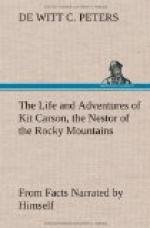The exploring party considered their labors finished at this post, as, in accordance with the tastes of many of the party, they were near enough to civilization. The command was dissolved, and Colonel Fremont proceeded on his route to Washington. Kit Carson, about the same time, started for Taos, where he had been for a long time anxiously expected by his family and friends.
The description which Colonel Fremont has given of the country through which this expedition traveled, seems to be an appropriate and almost a necessary addition to this work. On the 24th day of May the party, on their return, reached the Utah Lake. “Early the next day,” says Fremont, “we came in sight of the lake; and, as we descended to the broad bottoms of the Spanish Fork, three horsemen were seen galloping towards us, who proved to be Utah Indians—scouts from a village, which was encamped near the mouth of the river. They were armed with rifles, and their horses were in good condition. We encamped near them, on the Spanish Fork, which is one of the principal tributaries to the lake. Finding the Indians troublesome, and desirous to remain here a day, we removed the next morning further down the lake, and encamped on a fertile bottom near the foot of the same mountainous ridge which borders the Great Salt Lake, and along which we had journeyed the previous September.
“We had now accomplished an object we had in view when leaving the Dalles of the Columbia in November last; we had reached the Utah Lake; but by a route very different from what we had intended, and without sufficient time remaining to make the examinations which were desired. It is a lake of note in this country, under the dominion of the Utahs, who resort to it for fish. Its greatest breadth is about fifteen miles, stretching far to the north, narrowing as it goes, and connecting with the Great Salt Lake.
“In arriving at the Utah Lake, we had completed an immense circuit of twelve degrees diameter north and south, and ten degrees east and west; and found ourselves in May, 1844, on the same sheet of water which we had left in September, 1843. The Utah is the southern limb of the Great Salt Lake; and thus we had seen that remarkable sheet of water both at its northern and southern extremity, and were able to fix its position at these two points. The circuit which we had made, and which had cost us eight months of time, and 3,500 miles of traveling, had given us a view of Oregon and of North California from the Rocky Mountains to the Pacific Ocean, and of the two principal streams which form bays or harbors on the coast of that sea. Having completed this circuit, and being now about to turn the back upon the Pacific slope of our continent, and to recross the Rocky Mountains, it is natural to look back upon our footsteps, and take some brief view of the leading features and general structure of the country we have traversed. These are peculiar and striking, and




